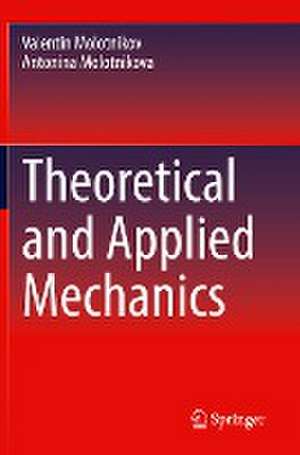Theoretical and Applied Mechanics
Autor Valentin Molotnikov, Antonina Molotnikovaen Limba Engleză Paperback – 9 noi 2023
| Toate formatele și edițiile | Preț | Express |
|---|---|---|
| Paperback (1) | 511.79 lei 6-8 săpt. | |
| Springer International Publishing – 9 noi 2023 | 511.79 lei 6-8 săpt. | |
| Hardback (1) | 667.38 lei 6-8 săpt. | |
| Springer International Publishing – 8 noi 2022 | 667.38 lei 6-8 săpt. |
Preț: 511.79 lei
Nou
Puncte Express: 768
Preț estimativ în valută:
97.96€ • 106.44$ • 82.34£
97.96€ • 106.44$ • 82.34£
Carte tipărită la comandă
Livrare economică 21 aprilie-05 mai
Preluare comenzi: 021 569.72.76
Specificații
ISBN-13: 9783031093142
ISBN-10: 3031093143
Pagini: 684
Ilustrații: XXVIII, 684 p. 335 illus., 15 illus. in color.
Dimensiuni: 155 x 235 mm
Greutate: 0.98 kg
Ediția:1st ed. 2023
Editura: Springer International Publishing
Colecția Springer
Locul publicării:Cham, Switzerland
ISBN-10: 3031093143
Pagini: 684
Ilustrații: XXVIII, 684 p. 335 illus., 15 illus. in color.
Dimensiuni: 155 x 235 mm
Greutate: 0.98 kg
Ediția:1st ed. 2023
Editura: Springer International Publishing
Colecția Springer
Locul publicării:Cham, Switzerland
Cuprins
Statics.- Kinematics.- Dynamics.- Theory of impact.- Elements of analytic mechanics.- Dynamics of controlled systems.- Stability of mechanical systems.- Basic concepts.- Structural analysis of mechanisms.- Kinematic analysis of mechanisms.- Dynamic analysis of mechanisms.- Initial concepts and definitions.- Calculation of parts in tension-compression.- Tense state. Strength theories.- Shear and torsion.- Bending.- Combined strength.- General theorems of mechanics.- Taking into account the forces of inertia.- Fatigue resistance.- Stability of compressed rods.- General information about machine design.- Precision manufacturing of machine parts.- Mechanical transmission.- Shaft and Axle.- Shaft and Axle Supports.- Couplings.- Connections of parts and units of machines.- Body parts of machines and mechanisms.- Index.
Notă biografică
Dr. Valentin Yakovlevich Molotnikov is a professor with Don State Technical University Southern Federal District, Rostov region, Rostov-on-Don in Russia. Dr. Antonina Aleksandrovna Molotnikova is a professor with the Rostov Institute of Entrepreneur Protection, Rostov-on-Don in Russia.
Textul de pe ultima copertă
This textbook summarizes the course of engineering mechanics, designed for one or two semesters, at the undergraduate or graduate level for a range of academic majors. The book covers all the main components of the discipline including: Theoretical Mechanics, Theory of Mechanisms and Machines, Resistance of Materials, Machine Parts and Design Basic; and Interchangeability, Standardization, and Technical Measurements. It can also be used by students of other technical areas in to achieve competence in each of the listed disciplines. The concise presentation facilitates concentration on the most important elements of the concepts presented while also outlining the current state of mechanics, demonstrating engineering applications using various computer packages (MathCad, CosmosWorks, Inkscape, AutoCad), and updating data on engineering materials. Examples of both simple and complex engineering calculations are given at the end of each chapter along with self-assessment questions.
- Presents the subject with a gradually increasing complexity;
- Reinforces key concepts with control questions and test items at the end of each chapter;
- Includes applications from various industries (mechanical engineering, construction) along with a detailed bibliography.
Caracteristici
Presents the subject with a gradually increasing complexity Reinforces key concepts with control questions and test items at the end of each chapter Includes applications from various industries (mechanical engineering, construction)
